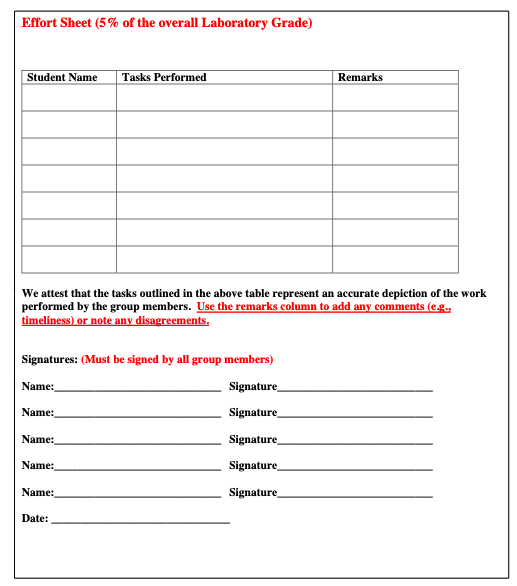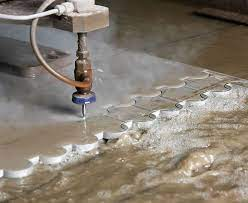Laboratory Reports¶
The primary deliverable is a laboratory report for each experiment.
General Concepts¶
A laboratory report is a type of memorandum. Memorandums (Memos) are a type of informal report. Memos should be clear and concise documents.
Some general guidelines regarding memos are: The purpose of the memo should be clearly stated. Headings may be used to improve clarity. In longer memos (such as laboratory reports for this class), you should summarize your message before going into a detailed discussion related the purpose of your memo. A memo should clearly state what you expect to happen next. You should normally provide a recommendation or a suggested action.
Format¶
Memorandum formats vary among organizations (a specific format for the laboratory reports is presented below). All memos have at least 4 parts:
a header section (similar to an address block in a letter),
a purpose section,
a discussion section, and
a recommendation section.
Some optional parts depending on the nature of the communication are summary sections and possibly supporting documents and/or data.
Header Section¶
The header section itself has four required components. The section must clearly state to whom the memo is addressed, from whom the memo originates, the date the memo is created and/or sent, and the subject of the memo. An optional component of the header is a list of those receiving a copy of the memo. This component often appears at the bottom of the memo as a distribution list.
Purpose Paragraph¶
The first sentence of the memo should tell the reader the topic of the memo. The reader will use this first paragraph to determine if the rest of the memo needs to be read.
Summary Paragraph(s) [optional]¶
For a longer memo, these paragraph(s) can be used to summarize the contents of the entire memo.
Discussion Paragraph(s)¶
These paragraphs provide the information the reader is expecting.
Action or Recommendation¶
The final paragraph(s) should provide a closing that is often recommendation or suggested action for what the reader should do next.
Memo Types¶
Some typical types of communications that are accomplished using memorandums are listed in the remainder of this section. This list is neither exhaustive nor exclusive.
Trip Reports¶
Trip reports are used to summarize the experiences of an employee had while away from the organization. The purpose is to provide the organization information about the trip. Trip reports can be used when an employee goes to visit a client or attends a conference.
Field or Lab Reports¶
When an employee provides an informal report of a field visit, or of some laboratory studies, a memo format can be used to summarize the work. The memo should still address the expected components of a lab reports such as: 1) purpose, 2) methods, 3)results 4) discussion of the results. In addition, the memo may suggest what should be done next.
Progress or Status Reports¶
Progress or status reports are used to provide a periodic update to a project. The memo should clearly state the progress of the project. If your project is not progressing well, say so! Projects can be salvaged or abandoned if detected early. Such memos typically just state the facts.
Directives¶
A directive is a memo that states what task or procedure you want the readers to undertake. Class assignments are directives, sometimes in a memo format.
With that introduction to written technical communication out of the way, here is the format for Lab Reports in this course, along with the point scale used.
CE 3105 Report Format¶
Page 1. - Cover page (3 points) Contains title of report, authors of report, dates of report (date of submission & date of experiment), and name of report recipient (Course Instructor). Also please include your course section number.
Page 2. – Table of Contents (5 points) Contains the contents of the report including a list of figures and a list of tables.
Page 3. - Theory page (22 points) Background - Contains an explaination of the theory/governing principles behind the experiment. Typically, it will involve application of the Continuity, Energy and/or Momentum Equations to a specific control volume and will result in either an equation for flow rate, pressure change or applied force that will be measured in the experiment. Describe any equations used to perform the analysis of the experiment.
Page 4. - Apparatus page (5 points) Contain a sketch of the apparatus and a list of the variables used/measured in the experiment (with units).
Page 5. - Results page (20 points) Contains graphs and tables of interpreted results. Results will involve a comparison between measured (from experiment) and predicted (from theory) results. Briefly explain your results. Label graphs and tables per ASCE format. Do not show a graph or a table without an explanation.
Page 6. - Discussion page/s (20 points) Contains a discussion of the results and should comprise;
A comment on whether the purpose of the experiment was meet, and if not, why not.
Answer specific questions in the Interpretation Section of the Experiment Instructions.
A discussion on where discrepancies and sources of error might arise.
A real life application of this apparatus/experiment.
Page 7. - Data Appendix (5 points) Contains the original data sheets for the experiment (Completely filled out).
Page 8. Error Analysis Calculations (10 points) Contains a sample calculation of error analysis for one lab trial. A table of calculated error analysis values for all trials will be included in the error analysis section.
Page 9. Sample Calculations (10 points) Contains a sample of your calculations, but not all repetitive calculations. Every equation used in a calculation needs to have a sample shown
Note
Here is an example redacted (actually Red-dacted) report from a previous semester that serves as a guide
CE 3105 Effort Sheet¶
A completed effort sheet below is to be submitted with your laboratory report.

You can download a copy of the effort sheet here
Warning
All team members must submit a copy of the team’s laboratory report, and the effort sheet to the server.
References¶
Markel, Michael (1998) Technical Communication, Situations and Strategies, 5th addition, St. Martins Press, New York
Purdue University Online Writing Laboratory (Google)
Young, Trevor M. (2005). Technical Writing from A-Z: A common sense guide to engineering reports and theses. ASME Press, New York
Holman, J.P., (2012) Experimental Methods for Engineers, 8th Ed. (Chapters 15 Report Writing)
